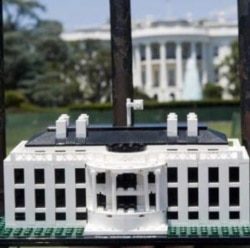Or download MP3 (Right-click or option-click and save link)
Architecture lovers in Washington do not have to travel far to see some of the world’s most famous buildings. Architect Adam Reed Tucker has recreated fifteen of them using Lego bricks. The exhibit is called “LEGO Architecture: Towering Ambition.” It is at the National Building Museum in Washington until early September. Faith Lapidus has more.
Lego bricks are small, colorful plastic blocks. They can be snapped together to make any number of objects. They are popular with children of all ages around the world.
Adam Reed Tucker calls himself an “architectural artist.”
He was a professional architect for ten years. After the terrorist attacks against the United States in two thousand one he decided to do something different. He wanted to express his feelings for the form of the skyscraper while deepening his understanding of architecture, engineering and construction. He chose to use something that most people used as children and could relate to.
The buildings in the exhibit include the World Trade Center in New York that was destroyed in the terrorist attacks; the Gateway Arch in Saint Louis, Missouri; the famous house called Fallingwater in Pennsylvania, designed by Frank Lloyd Wright; and the Burj Khalifa in Dubai, the tallest building in the world. Tucker used more than four hundred fifty thousand Legos to make his version which is more than five meters tall.
Tucker does all his work by hand, using only pictures of the buildings. He does not use any computers or drawings to plan his buildings. While the exhibit is going on, Tucker will be working on his latest work, the White House where the American president lives. Visitors can watch him create the famous building brick by brick.
Anne Bennett visited the Building Museum with her two grandchildren, Dylan and Daisy. She used the Lego exhibit to teach her grandchildren about famous buildings.
“My favorite is probably that tall building because it’s made out of Legos. It’s really cool because it looks like there’s individual little rooms.”
That was Anne’s granddaughter, Daisy. She was talking about the Willis Tower, formerly known as the Sears Tower in Chicago, Illinois. The real building is over four hundred forty meters tall. Tucker’s model stands six meters tall.
After walking through Tucker’s models, visitors can create their own works at the building station. They can make houses, office buildings, stores or factories. They can then place their models on a large map of a city. As more visitors come, the Lego city will grow.
Lowry Baker came from McLean, Virginia, to see the exhibit.
“When we saw the models it was just amazing. The models seem like a perfect rendition of the actual buildings. And then of course as soon as my son got a look at all of the stations here he just made a beeline because he wanted to start building. It’s really a great set-up. It really encourages creativity on the kids’ parts.”
Paul lives in Washington and brought his baby daughter along to see the Lego exhibit.
“You know, I love architecture, so … and growing up I loved Legos. So you know throw those two together and I’ll come running to check this out regardless of whether she cares or not.”
To many people, Legos might seem like toys for kids. But Adam Reed Tucker proves that the only limit to what the toy can do is a person’s imagination.





